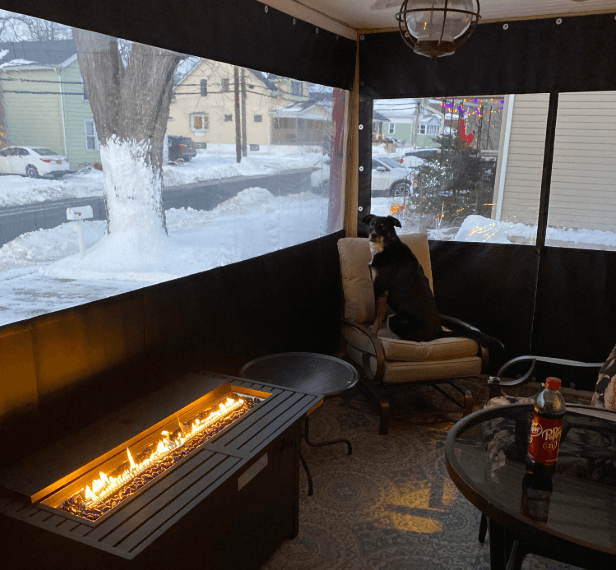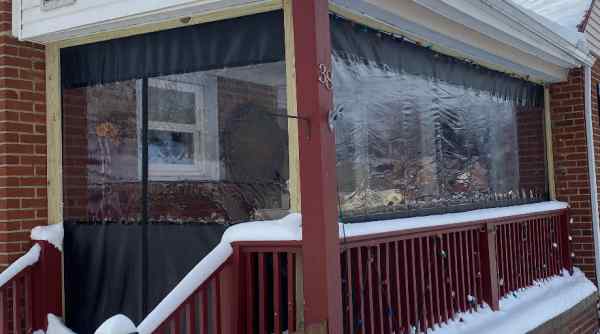
 One of our New York customers sent us these photos showing how they used our heavy duty tarps to enclose their porch area, featuring large windows and a zippered doorway. This is a great way to extend your living space over the winter and provide a cozy area with a nice view of your surroundings.
One of our New York customers sent us these photos showing how they used our heavy duty tarps to enclose their porch area, featuring large windows and a zippered doorway. This is a great way to extend your living space over the winter and provide a cozy area with a nice view of your surroundings.
One thing to be cognoscente of when designing such an enclosure is the method by which you plan to heat the area. Open flames, as we see here, could result in the release of carbon monoxide, which can be deadly.
Continue reading to learn more about carbon monoxide poisoning and what you should do to keep your family, including your pets, safe.
Carbon monoxide (CO) is a colorless, odorless, and tasteless gas that poses significant health risks, especially when generated indoors or in an enclosed outdoor area like the one we show here. It is crucial to be aware of the dangers of CO poisoning when designing tarped enclosures for activities like barbecuing or when using indoor fire grates or other combustion-based heat sources.
Carbon monoxide is produced by the incomplete combustion of fuels such as gas, oil, coal, and wood. Common sources include gas stoves, heaters, fireplaces, and grills. When these appliances are used in enclosed spaces without proper ventilation, CO can accumulate to dangerous levels.
Exposure to carbon monoxide can lead to a range of symptoms, which may be mistaken for other illnesses, these include:
In severe cases, CO poisoning can be fatal.
If you suspect CO poisoning, leave the enclosed area immediately and move to fresh air. Call emergency services or seek medical attention promptly. Avoid re-entering the area until it has been declared safe by professionals.
To protect yourself and others from CO poisoning, consider the following precautions:
Ensure that any enclosed space used for activities like barbecuing or using fire grates is well-ventilated. Usually, this means having more than one venting area to allow for airflow from one vent to another. We can add screened windows to your tarp with Velcro sealable flaps to provide venting when needed.
Ideally, you should only use appliances, such as electric heaters, that are designed for indoor use only. This is particularly true if your enclosure is completely sealed from the outside. Think of this area as an extension of your home, if you would not barbeque in your kitchen, don't do so in your tarped enclosure.
If you plan to use any appliance that involves combustion, be sure to place CO detectors, directly within the enclosure, to warn you of the presence of carbon monoxide. It is wise to have carbon monoxide detectors on every floor of your home, particularly near your furnace and sleeping areas. Regularly test and maintain detectors to ensure they function correctly. Even if you use electric heat, there is risk of carbon monoxide exposure from things like outdoor grills, idling vehicles or portable generators used during power outages.
Have fuel-burning appliances, such as furnaces and wood stoves, inspected and serviced annually by a qualified professional. Ensure that chimneys and vents are clear of obstructions.
Inform all household members about the dangers of CO and the importance of ventilation.
Several household appliances can produce carbon monoxide if not properly maintained or used inappropriately:
Using gas stoves or ovens for heating or cooking in enclosed spaces without proper ventilation can lead to CO buildup.
Both gas and wood-burning fireplaces can emit CO if chimneys are blocked or if used improperly.
Unvented kerosene or gas space heaters can produce CO, especially in poorly ventilated areas.
Running gasoline-powered generators indoors or in attached garages can lead to dangerous CO levels.
Using charcoal or gas grills indoors or in enclosed patios can produce lethal amounts of CO.
Recent incidents underscore the critical importance of CO safety:
A woman in the UK suffered from severe health issues, including headaches and dizziness, for three years due to CO poisoning from a poorly fitted boiler. Initially misdiagnosed with early-onset dementia, the true cause was only discovered during a routine boiler check.
In an article in The Scottish Sun, Dr. Punam Kirshan warns about the dangers of CO poisoning, particularly during colder months when symptoms can be mistaken for common colds or flu. She emphasizes the importance of recognizing if symptoms worsen indoors, which may indicate CO exposure, and urges people to use CO alarms and get gas appliances checked regularly.
Carbon monoxide poisoning is a serious and often overlooked hazard, especially for those using enclosed spaces for activities like barbecuing or using fire grates. By understanding the risks, recognizing symptoms, and implementing preventive measures, you can protect yourself and your loved ones from this silent killer. When designing your tarped enclosures, speak to us about adding sealable vents to your tarps to allow you to open windows when barbequing or using other forms of combustion.